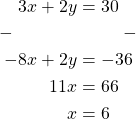Where two numbers are unknown, we need two independent relations for those two numbers to calculate their respective values.
Example:
![Rendered by QuickLaTeX.com \[\begin{cases}3x+2y=30 \\ y-4x=-18 \end{cases}\]](http://www.tentotwelvemath.com/wp-content/ql-cache/quicklatex.com-cb9da72acf032a4c5fb93d771d83b7a7_l3.png)
When graphed, both of these relations form straight lines, however the methods here are not restricted to linear equations.
Each equation gives new information about how ![]() and
and ![]() are related to each other.
are related to each other.
Take one equation on its own: ![]() . There are infinitely many values of
. There are infinitely many values of ![]() and
and ![]() that work in this equation – eg,
that work in this equation – eg, ![]() and
and ![]() . There are infinitely many ordered pairs
. There are infinitely many ordered pairs ![]() that satisfy this equation.
that satisfy this equation.
However when graphed together, straight line graphs fall into one of three categories:
- parallel and never intersect – no common point;
- not parallel, intersect at one and only one point;
- parallel and always intersect – that is, the lines are coincident.
When graphed, it is obvious what category our set of equations fall into. However without the graph the algebra will let us know:
- if they are parallel and don’t intersect, our algebra has a final line such as
 which makes no sense. This is a contradiction informing us that no values will work in both equations.
which makes no sense. This is a contradiction informing us that no values will work in both equations. - if they are not parallel and intersect at one and only one point, our algebra will result in the unique values of
 and
and  of this point.
of this point. - if they are coincident, are algebra will end up with a linear relationship between
 and
and  , such as
, such as  – meaning that any point on this line is on both lines, all are solutions to the system. There are infinitely many solutions.
– meaning that any point on this line is on both lines, all are solutions to the system. There are infinitely many solutions.
Solve with Substitution
![Rendered by QuickLaTeX.com \[\begin{cases}3x+2y=30 \\ y-4x=-18 \end{cases}\]](http://www.tentotwelvemath.com/wp-content/ql-cache/quicklatex.com-cb9da72acf032a4c5fb93d771d83b7a7_l3.png)
First, let’s isolate either ![]() or
or ![]() in one or the other of the equations. In this case, it is easy to isolate
in one or the other of the equations. In this case, it is easy to isolate ![]() in the second equation.
in the second equation.
![Rendered by QuickLaTeX.com \[\begin{cases}3x+2y=30 \\ y=4x-18 \end{cases}\]](http://www.tentotwelvemath.com/wp-content/ql-cache/quicklatex.com-955c1cec2aeb4bf2e005712bdae032b7_l3.png)
Now we take the expression for ![]() in the second equation and substitute it to the first, as follows:
in the second equation and substitute it to the first, as follows:

Finally, substitute this value of ![]() into the equation
into the equation ![]() (or the other equation) to find
(or the other equation) to find ![]() .
.
![]()
Solution: ![]() ,
, ![]() .
.
Check to see that this solution works in the both of our original equations.
Solve with Elimination
![Rendered by QuickLaTeX.com \[\begin{cases}3x+2y=30 \\ y-4x=-18 \end{cases}\]](http://www.tentotwelvemath.com/wp-content/ql-cache/quicklatex.com-cb9da72acf032a4c5fb93d771d83b7a7_l3.png)
First, it is helpful to align the unknowns:
![Rendered by QuickLaTeX.com \[\begin{cases}\,3x+2y=30 \\ -4x+y=-18 \end{cases}\]](http://www.tentotwelvemath.com/wp-content/ql-cache/quicklatex.com-313effa6400368fc9826c7bbe9fd30b3_l3.png)
Next, we examine to see if any unknown (either ![]() or
or ![]() ) has the same coefficient in both equations. This is not true in our example.
) has the same coefficient in both equations. This is not true in our example.
We could:
- Multiply the first equation by 4 and the second equation by 3 to have
 in both equations, or
in both equations, or - Multiply the second equation by 2 to have
 in both equations.
in both equations.
The latter is more efficient. Multiplying the second equation by 2 gives:
![Rendered by QuickLaTeX.com \[\begin{cases}\,3x+2y=30 \\ -8x+2y=-36 \end{cases}\]](http://www.tentotwelvemath.com/wp-content/ql-cache/quicklatex.com-d3730795bee48f049446a964476b67a6_l3.png)
Subtract equation 2 from equation 1 to eliminate the ![]() term:
term:

or, more simply:

Now substitute this value of ![]() into the equation
into the equation ![]() (or the other equation) to find
(or the other equation) to find ![]() .
.
![]()
Solution: ![]() ,
, ![]() .
.
Videos
Applet to practice both techniques:
Modelling with Systems of Equations
Check out this selection of questions on Khan Academy.
